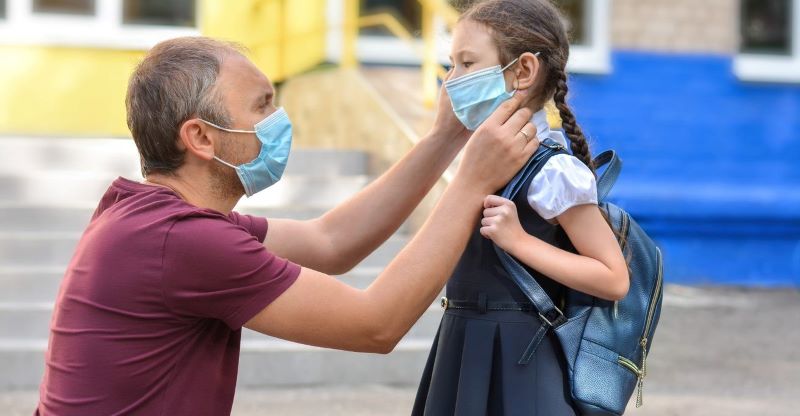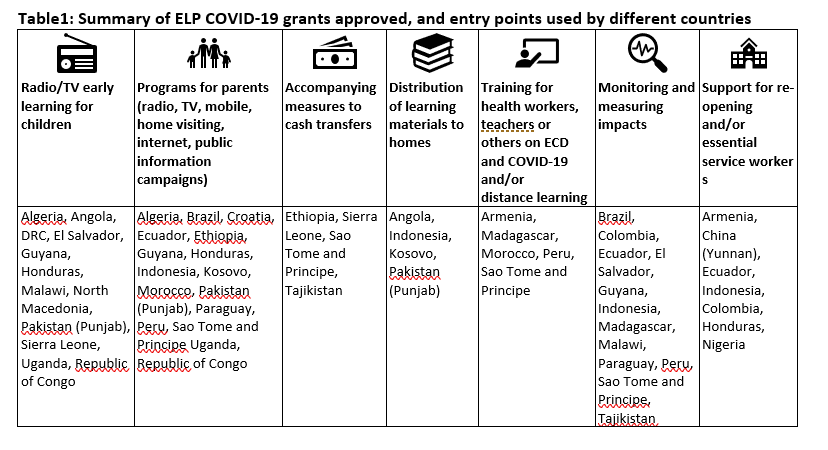 A photo of a father saying goodbye to his child by the school gate.
A photo of a father saying goodbye to his child by the school gate.
Young children and their families have been particularly vulnerable during the COVID-19 crisis. A survey of caregivers during COVID-19 in Pakistan found that emotional well-being of some children deteriorated significantly, particularly for those from poorest households and with parents also experiencing distress. In Kenya, during the peak of the lockdown, over 11% of children under the age of four went to bed hungry.
A forthcoming report found that 19% of households in Mexico with young children experienced job loss. This shock was twice as large for poorer households. In these households, young children were more likely to spend time unsupervised and experienced a significant reduction in stimulation activities with caregivers (such as reading stories or playing).
Recognizing the vulnerability of young children and their parents during the COVID-19 crisis, in the spring of 2020, the World Bank’s Early Learning Partnership (ELP) team mobilized to provide Bank teams and client countries with resources needed for young children and their families. This included the guidance note 15 Ways to Support Young Children during the COVID-19 crisis, a series of staff learning events and the development of a ECD COVID-19 phone survey.
We also completed an emergency COVID-19 funding round, which provided grants (up to $50,000 USD) to World Bank teams to work with governments to support young children and families, with 28 proposals from 28 countries, worth $1.1 million USD, approved. Many grants are implementing some of the ideas suggested in our guidance note and the majority are directly supporting parents remotely to provide care and learning opportunities for their children. Almost all grants finance activities that tap into existing infrastructure and delivery channels, linking to World Bank projects and government programs already operating at scale. Many grants have ensured that ECD is included in government COVID-19 responses when before programs did not necessarily provide support to young children. At approval, the grants were expected to reach 19.5 million children and 20.7 million parents; initial results, however, indicate that the total numbers reached will be substantially higher.
- When reaching families remotely, have multiple touch points and deploy a range of mechanisms to reach and communicate with families - from regular phone calls to parents to mass communications campaigns. In Indonesia, Bank teams supported the government’s “My Home My School” remote learning program to empower teachers and parents to support young children’s development during school closure. ELP funds also supported the development of national ECD COVID-19 response guidelines, manuals for parents and teachers with home-based ECD curriculum, videos for public education, technical support to deliver the program, and progress monitoring. The program has already reached 11.5 million young children.
- Strategies should be tailored to the connectivity, needs, and behaviors of the families. When designing the remote counselling intervention, the team in Peru worked with government to categorize the levels of connectivity of families, and developed tailored communication strategies to reach them. Families in rural areas were difficult to reach as many did not have mobile phones or radios, so community leaders were mobilized using existing communication methods, such as walkie-talkies and loudspeakers. By analyzing monitoring data, the team found that families preferred to receive messages in the afternoon since parents, especially mothers, were busy with household activities in the morning.
- Even in an emergency response, system strengthening is key to delivering quality services at scale. In Colombia, ELP resources were used to develop the Bienestar (“Well-being”) app to monitor ECD service delivery under the government’s Mis Manos te Enseñan (My Hands Teach you) Initiative that supports young children and families during the COVID-19 crisis. Families use the app to report problems with delivery or quality of the food or materials and to monitor their children’s developmental progress. This enabled the government to tailor support to families’ needs and to better promote children’s early learning. The data from the app will also help improve the procurement mechanisms and inform the incorporation of the remote monitoring approach and the Bienestar app into in-person ECD services in the future.
- There is an opportunity to use resources and programs developed in response to the COVID-19 crisis in the medium term and bring them to scale. In Ethiopia, posters and brochures with messaging on coping/stress management, nutrition, hygiene, playful parenting and early stimulation have been developed and distributed to beneficiaries of the Bank’s Urban Productive Safety Nets Project and ECD messages for radio and television have been produced. Building on this initial success, donors are providing additional financing to expand the number of radio and television messages from 12 to 24, with an objective of reaching 3 million children and caregivers with ECD messaging.
- The unique nature of the pandemic has highlighted what we’ve known all along: parents are key to ensuring children’s survival, care and learning and it is critical to support them directly . Interventions that support parents to support their children should continue to be central to the efforts that support human capital growth even beyond the current crisis.
The ELP COVID-19 grants are expected to conclude within a few months, and we’ll provide a final update later in the year.




Join the Conversation